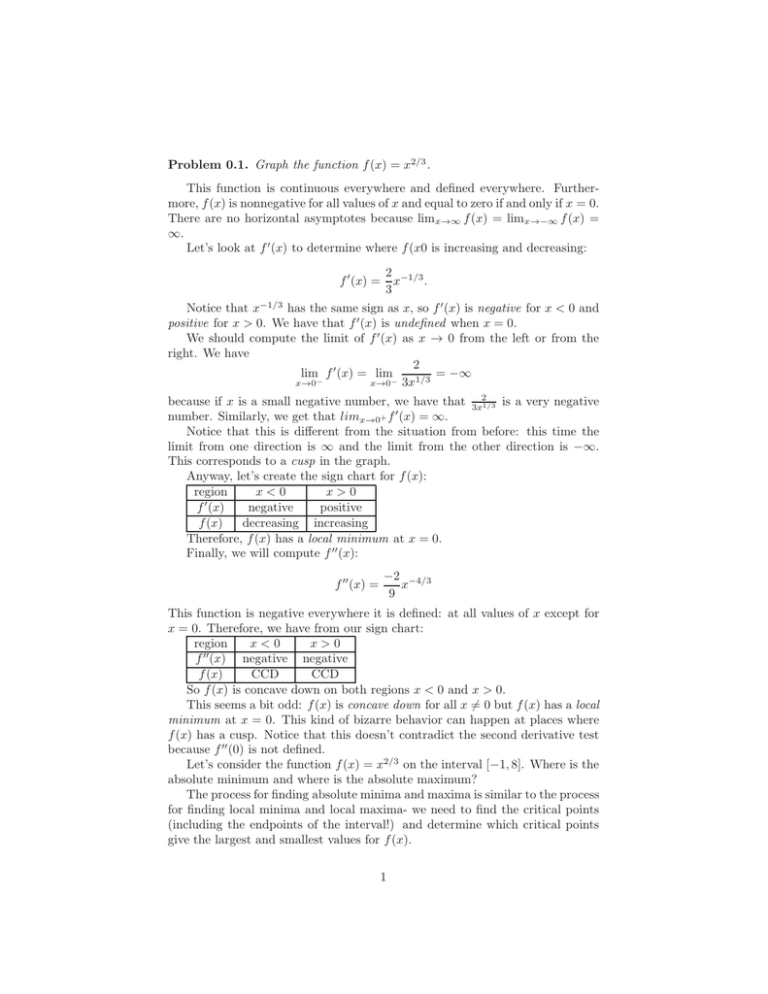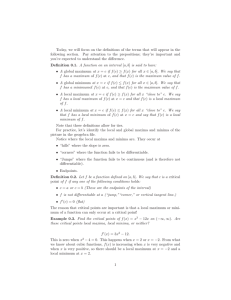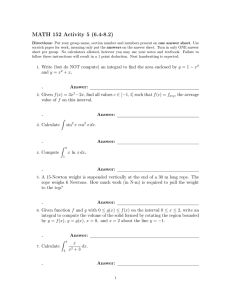(x) = x Problem 0.1. Graph the function f .
advertisement

Problem 0.1. Graph the function f (x) = x2/3 . This function is continuous everywhere and defined everywhere. Furthermore, f (x) is nonnegative for all values of x and equal to zero if and only if x = 0. There are no horizontal asymptotes because limx→∞ f (x) = limx→−∞ f (x) = ∞. Let’s look at f ′ (x) to determine where f (x0 is increasing and decreasing: 2 −1/3 x . 3 Notice that x−1/3 has the same sign as x, so f ′ (x) is negative for x < 0 and positive for x > 0. We have that f ′ (x) is undefined when x = 0. We should compute the limit of f ′ (x) as x → 0 from the left or from the right. We have 2 = −∞ lim f ′ (x) = lim x→0− x→0− 3x1/3 f ′ (x) = because if x is a small negative number, we have that 3x21/3 is a very negative number. Similarly, we get that limx→0+ f ′ (x) = ∞. Notice that this is different from the situation from before: this time the limit from one direction is ∞ and the limit from the other direction is −∞. This corresponds to a cusp in the graph. Anyway, let’s create the sign chart for f (x): region x<0 x>0 f ′ (x) negative positive f (x) decreasing increasing Therefore, f (x) has a local minimum at x = 0. Finally, we will compute f ′′ (x): f ′′ (x) = −2 −4/3 x 9 This function is negative everywhere it is defined: at all values of x except for x = 0. Therefore, we have from our sign chart: region x<0 x>0 f ′′ (x) negative negative f (x) CCD CCD So f (x) is concave down on both regions x < 0 and x > 0. This seems a bit odd: f (x) is concave down for all x 6= 0 but f (x) has a local minimum at x = 0. This kind of bizarre behavior can happen at places where f (x) has a cusp. Notice that this doesn’t contradict the second derivative test because f ′′ (0) is not defined. Let’s consider the function f (x) = x2/3 on the interval [−1, 8]. Where is the absolute minimum and where is the absolute maximum? The process for finding absolute minima and maxima is similar to the process for finding local minima and local maxima- we need to find the critical points (including the endpoints of the interval!) and determine which critical points give the largest and smallest values for f (x). 1 We recall that the derivative f ′ (x) is defined everywhere and nonzero, except at x = 0 where f (x) is not differentiable. Therefore, we need to test x = −1, x = 0, and x = 3. Notice that f (−1) = 1, f (0) = 0 and f (3) = 82/3 = 4. Because f (0) is the smallest, f (x) attains its absolute minimum on [−1, 8] at x = 0, and because f (8) is the largest, f (x) attains its absolute maximum on [−1, 8] at x = 8. This gives the following procedure for determining where the locations of absolute minima and maxima are: • Locate the critical points of f (x) (including the endpoints). • Compute f (x) at each of the critical points of f (x) (including the endpoints). • The largest of these values is the absolute maximum of f (x) on the interval and the smallest of these values is the absolute minimum of f (x) on the interval. Example 0.2. Compute the absolute maximum and absolute minimum values of f (x) = x3 − 5x2 + 3 on the interval [0, 5]. Taking the derivative, we get f ′ (x) = 3x2 − 10x, which is equal to zero at x = 0 and at x = 10 3 . Therefore, our critical points (including the endpoint x = 5 are x = 0, X = 10 3 , and x = 5. We compute f (0) = 3 10 1000 − 1500 + 81 −419 f( ) = = 3 27 27 f (5) = 3 So f (x) attains its maximum value of 3 at x = 0 and x = 5, and attains its 10 minimum value of −419 27 at x = 3 . 2




